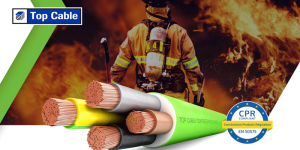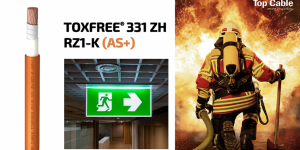TOXFREE® RZ1-K 0.6/1kV is a halogen-free flexible power cable with low smoke emission and no…
Differences between halogen free and fire resistant cables
When starting a project in public spaces it is recommended to “plan for the worst case scenario”. It is of utmost importance that everyone involved in a new project understands when to use PVC cables, when to use LSZH (Low Smoke Zero Halogen) cables and when to use fire resistant cables. In order to make a good decision, it is important to know what the differences are and what needs to be considered in order to make the right choice.

WHAT IS THE DIFFERENCE BETWEEN PVC, LSZH AND FIRE RESISTANT CABLES?
The characteristics of the cables determine to a large extent the use and application in each case. For example, the excellent electrical performance of PVC cables makes them ideal for use in industrial environments. However, in the event of a fire, they are not the most suitable for the safety of the people who may be there. These cables produce a large amount of smoke, acids and toxic gases, which can have serious consequences for people.
LSZHF cables, also known as halogen free cables, are highly recommended for installation in areas of high public traffic. We are refrring, for example, to hospitals, airports, tunnels, subways, museums, as well as in offices, production plants, laboratories, etc. In this case, these cables have been designed to offer maximum protection to people in the event of fire. They do not spread fire (preventing it from reaching a new area), but also do not emit toxic or corrosive substances and have low smoke emissions. This facilitates the evacuation of people and the work of rescue personnel.
In the event of a fire, these two types of cable interrupt the power supply to the circuits connected to them.
Fire resistant cables are the only cables that have the ability to continue to maintain the power supply when they come into contact with flames, in case of fire. In this way, the operation of emergency equipment such as acoustic alarms, smoke extractors or forced ventilation, emergency signalling and lighting, water pumps, inert network and/or fire brigade, automatic door opening, video surveillance cameras, etc. can be guaranteed. All this support allows for a much faster and more effective evacuation.
EUROPEAN CPR REGULATION
European CPR regulations oblige cable manufacturers to carry out reaction to fire tests in official laboratories. Subsequently, the official results of these tests will indicate the performance of these fire resistant cables, reflected in classes B2ca, Cca, Dca or Eca. Finally, depending on the result, the cable will be more or less suitable for installation in critical places such as those mentioned above.
These classes and their classification criteria can be summarised in this table:
| Classes | Smoke | Droplets | Acidity | ||||
| Benefits | Benefits | Benefits | Benefits | ||||
| B2ca | Very high | s1a | Very high | d0 | Very high | a1 | High |
| Cca | High | s1b | High | d1 | High | a2 | Media |
| Dca | Basic | s2 | Media | d2 | Basic | a3 | Basic |
| Eca | Basic | s3 | Basic |
The CPR sets a higher safety standard that raises the performance of conductors against the spread of fire and also provides features that the international IEC standard did not consider. These include improved smoke behaviour, droplets that self-extinguish in a standardised time and improvements against acidity and toxicity. You can find more information about CPR in this video.
With these features and with the seal of flexibility that we invite our customers to check, Top Cable consolidates its commitment to present solutions with a high standard, certifications that validate their characteristics and, of course, a team prepared to meet the requirements.
HOW DO FIRE RESISTANT CABLES ENSURE SAFETY IN CASE OF FIRE?
Fire resistant cables must comply with a structure that allows them to fulfil their purpose at all times. Thus, the main objectives are twofold: to guarantee the safety of the people who are there and to ensure that the electrical circuits essential for the evacuation of people continue to function.
They must be halogen-free cables and prevent the spread of fire, thus keeping the fire under control. If you meet these requirements, your conductor can be classified as High Safety, (AS) or even (AS+).
WHAT HIGH SECURITY CABLES CAN TOP CABLE OFFER?
Among Top Cable’s wide range of cables we find a cable that meets all the requirements. It is LSZH (flame-retardant, non-flammable, non-fire-retardant, no fumes or corrosive gases), with the additional feature of being fire-resistant. Thus, it safeguards the integrity of safety circuits. These cables are called AS+.
This high-performance cable in our catalogue is the TOXFREE® PLUS ZH 331 RZ1-K (AS+). It meets all the requirements for high-safety LSZH cables and also offers AS+ fire resistance.




